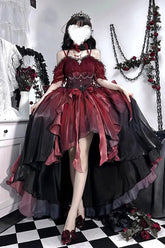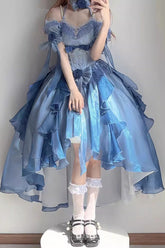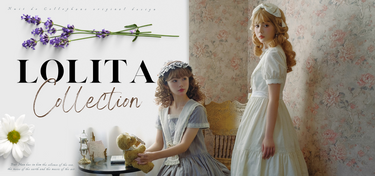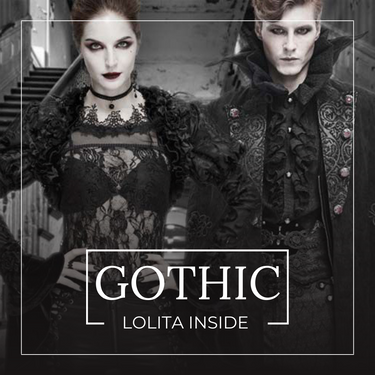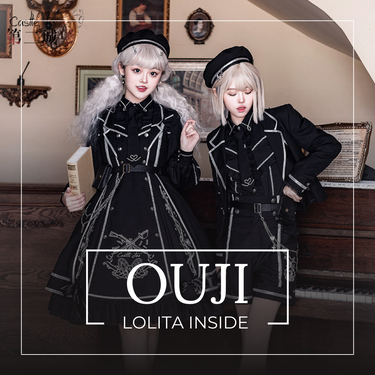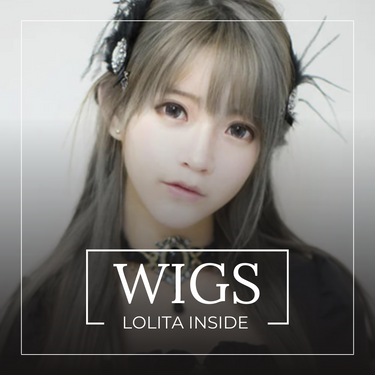What is Lolita
What is Lolita?

Image Source from Lolita indie brands: Sweet Date, Ballet Circus Hanayome Sweet Princess Lolita Jsk Dress 2 Colors
Victorian attire and Rococo-era fashions strongly influenced the Japanese subculture known as "Lolita fashion." The cutesy aesthetic is one of Lolita fashion's most defining characteristics. The three primary substyles of this clothing subculture are "Gothic," "Classic," and "Sweet." In addition, there are numerous more substyles such as 'Punk', 'Shiro' (white), 'Kuro' (black), 'Hime' (princess), 'Country', 'Guro' (grotesque), 'Qi' and 'Wa', and 'Steampunk' Lolita. In the 1990s and 2000s, this look developed into a popular subculture in Japan and other nations. However, as fashion got more mainstream in the 2010s, it's possible that this subculture faded in Japan.
Lolita Fashion: Embracing Elegance and Whimsy"
Lolita fashion is a distinct and intriguing subculture that has won over admirers from all over the world. This fashion style, which has its roots in Japan, has developed into a colourful and varied mode of self-expression that honours grace, nostalgia, and originality. We will examine Lolita fashion's history, essential components, and influence on contemporary fashion and culture as we delve into its subtleties in this article.
Origin of Lolita fashion
The origins of Lolita fashion can be traced back to the late 1970s and early 1980s in Japan. Inspired by the Rococo and Victorian eras, as well as the fashion of the Edwardian and Baroque periods, Lolita fashion emerged as a response to the mass-produced, Western-influenced clothing that dominated Japanese fashion at the time. The desire to return to more traditional and romantic aesthetics led to the birth of Lolita fashion.
In this context, the term "Lolita" does not refer to the controversial novel by Vladimir Nabokov but rather to the idea of youthful innocence and beauty. The fashion movement took its name from the novel "Lolita" due to its association with the doll-like, girlish aesthetic that defines the style.
Key Elements of Lolita Fashion
- Dress code
Lolita fashion follows a strict dress code that expresses innocence and charm altogether. It consists of two components: the color palette and the silhouette. You can find knee-length or ankle-length dresses in this dress code to give girls a feminine and sweet look. Most attire consists of feminine hues like lavender, baby blue, white, or pink with A-line or empire waistlines.
Sometimes, these dresses are adorned with laces, ruffles, and delicate details enriched with pastels, jewel tones, and black and white themes. These colors symbolize the innocence and romanticism associated with Lolita fashion.
While the dress design patterns include polka dots, stripes, or florals, various accessories like headbands, petticoats, socks, and gloves are usually incorporated. These items help create the desired Lolita aesthetic and add cuteness and a touch of elegance to the dress.
- Shoes and accessories
You can find quite a distinguishing type of shoes in Lolita fashion as they are typically flat, square toes and adorned with embellishments like bows, lace or stones. They show a woman's feminine aesthetic with a soft and velvety touch. You will feel a sense of comfort and luxury while wearing these dresses and other accessories like soft neck chokers, brooches, and bags. The attention to detail in accessorizing is a hallmark of Lolita fashion.
- Hairstyles and makeup
Not only do the dress code or accessories belong to Lolita fashion, but they also complement the hairstyling and makeup to give you a perfect Lolita look. This trend reveals soft buns, curls adorned with ribbons or flowers, and a pigtail hairstyle. Of course, this fashion is a name of distinction, allowing you to look perfectly Lolita with rosy lips, eyeliner and pinkish cheeks. Keeping the makeup soft and light will enhance the personal touch and show creativity and self-expression.
Substyles of Lolita Fashion
Many substyles have emerged in the Lolita fashion community with their own distinctive characteristics and influences, and here are some of the major ones.

Image Source from Lolita indie brands: ZhiJinYuan, Pink Floating Light Dance Multi-Layer Ruffle Embroidery Bowknot Lace Sweet Lolita Jsk Dress
- Sweet Lolita:

Image Source from Lolita indie brands: Loli Cat, Glaze Fantasy Short Sleeves Ruffle Embroidery Bowknot Sweet Lolita Op Dress 6 Colors
It is a popular Lolita fashion style that focuses on a childlike look with innocence, using pastel colours and motifs such as ribbons and bows to show playful charm.
- Gothic Lolita:

Image Source from Lolita indie brands: Yingluofu, Black Starry Night Square Collar Bowknot Multi-Layer Ruffled Cardigan Gothic Lolita JSK Dress With Detached Sleeves
It goes with the name Gothic and Victorian, and its look includes darker colour shades adorned with laces and a mature aesthetic.
- Classic Lolita:

Image Source from Lolita indie brands: Dust Song, Wine Vintage Palace Style Ruffled Stripe Print High Waisted Classic Lolita Dress Skirt
The classic style Lolita offers muted colours, mature looks and intricate patterns to focus on historical elements of Edwardian eras.
- Punk Lolita:
This substyle creates a unique blend of traditional silhouettes with motifs with edgier accessories. It's a name of elegance and rebelliousness aesthetic.
Evolution of Lolita Fashion Over Time
You may be curious about the evolution and transformation of Lolita fashion. The idea emerged in the 1970s and slowly increased globally due to the influence and popularity of fashion.
Worldwide Growth
Lolita fashion started to become popular outside of Japan as interest in it grew beyond its birthplace of Japan. An important publication devoted to the look, The Gothic & Lolita Bible, was translated into English and disseminated worldwide, helping to raise awareness of Lolita fashion on a global scale. The style was also made popular by the internet, which paved the way for opening Lolita fashion stores abroad, like Baby, The Stars Shine Bright in Paris and New York.
Media and publications influence
The fashion media greatly aided the popularization and further dissemination of Lolita fashion. The Gothic & Lolita Bible, among other periodicals and publications, promoted the fashion and subcultures, augmenting its prominence and allure. But the Lolita fashion media scene changed, with magazines like FRUiTS going out of print and the Gothic & Lolita Bible going on hiatus before coming back in various guises in the following years.
Subgenres and Adaptability
Lolita fashion evolved into a number of substyles over time, each having unique traits and inspirations. Subcultures that catered to various aesthetic tastes and added to the richness and diversity of the Lolita fashion subculture included Sweet Lolita, Gothic Lolita, Classic Lolita, and Punk Lolita.
Global Community and Online Presence
The creation of internet forums and communities gave fans a place to talk about, exchange, and celebrate Lolita fashion, further fueling its expansion. These virtual forums enabled the sharing of outfits, the exchanging of styling advice, and the establishment of an international network of enthusiastic people about Lolita fashion. Furthermore, well-known Japanese brands opened outlets abroad due to the increased interest in Lolita fashion worldwide, thus enhancing its global reach.
Cultural and Stylistic Adaptations
Lolita fashion has always changed to reflect shifting societal influences and fashion trends. The style's fundamental aesthetic values have been preserved, and it has changed to include contemporary components. Wa’ Lolita, for instance, exhibits the versatility and inventiveness of the Lolita fashion subculture by fusing Victorian design with Japanese fashion components, including the kimono.
Lolita Fashion's Effect
Beyond its Japanese roots, lolita fashion has become popular worldwide, attracting devoted communities and events in several nations. The trend has influenced the mainstream fashion industry, leading designers to use parts of Lolita aesthetics in their collections. Furthermore, many people now use Lolita fashion as a means of artistic expression and self-actualization, embracing their uniqueness and creativity via clothing.
Lolita fashion has been highlighted in a number of popular media, such as movies, music videos, and books, which has increased its appeal and visibility. The subculture has sparked Numerous online forums where fans can interact with like-minded people passionate about this unusual fashion movement, swap outfits, and trade styling advice.
Lolita fashion still represents artistic freedom and individuality even as it develops. Social media and online networks have allowed people from many backgrounds to get together and explore this unique style in a friendly environment. As fresh generations of fans redefine and reinterpret the style, Lolita fashion is expected to continue evolving and inspiring new generations of designers for years to come.
Final thoughts
Lolita fashion's fascinating and diverse subculture honors originality, grace, and inventiveness. The development of Lolita fashion has been characterized by its diversification into substyles, globalization, media and publishing influence, global community building, and adaptability to shifting cultural and stylistic influences. As a distinctive and timeless mode of artistic expression and self-expression, Lolita fashion endures in the face of shifting trends in the fashion industry and the larger cultural milieu.
Recall that Lolita fashion has developed throughout time, impacted by media, worldwide trends, and the ingenuity of its devotees, rendering it a vibrant and always evolving subculture within the fashion industry. You can visit https://www.lolitainside.com/collections/lolita-fashion to buy the clothes you desire. To celebrate your event, you will find everything related to Lolita fashion.
